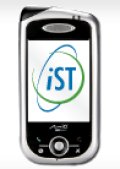|
|
 |
 |
 |
 |
| PocketGPSWorld.com Event Article |
|
 |
 |
 |
 |
 |
 |
 |
 |
Compass Points to the Future of POIs
 Intelligent Spatial Technologies (iST) are currently demoing their iPointer, (tagged "TV Remote for the Real World") at CTIA Wireless 2009, Las Vegas. Intelligent Spatial Technologies (iST) are currently demoing their iPointer, (tagged "TV Remote for the Real World") at CTIA Wireless 2009, Las Vegas.
iPointer is a fascinating new idea whereby you simply point your mobile phone or PDA at a nearby building or POI (point of interest) and it pulls up information about it. You're supplied with all sorts of details, such as the building or landmark's name, what's its use, opening times, special interest information, history, etc. It cuts out the time identifying the name of the building and having to search the net for it. So far, iST has aggregated information on 50 European cities and 58 in the US.
Rather than attempt to explain the technology behind it myself, according to the iST website, pointing based search generally refers to a search technique that allows a user to input spatial data to a computer by using a pointing device to identify an object of interest and then receive information related to that object.
To perform pointing based search with the iPointer, the user first activates an iPointer Client application on a cell phone or PDA. Once the application is running, the user simply points the handset at a landmark, building, or point of interest, and clicks a selector button. The iPointer client then builds its search criteria with input from a GPS receiver (position) and a digital magnetic compass (orientation) and sends it to the iPointer Server. The GPS and compass can either be on board the handset or made available as an accessory device connected via Bluetooth technology.

The iPointer geospatial search engine receives the search criteria and identifies the physical location that the user has selected using patent-pending pointing based search algorithms. Once the location has been identified, relevant location-specific content is assembled by the iPointer's content aggregation logic and delivered to the user's handset.
When the search results are returned, the iPointer client prepares the results for display to the end-user. In some cases, the search results may be augmented with data stored in a local content cache (e.g., compact flash memory) at the handset. This technique can be useful when the number of potential searches for a particular area is finite and the search results include multi-media content (e.g., a tour of a historic battlefield).
I asked their CEO, Chris Frank for some background about Maine based iST and iPointer.
Read more...
Article by robert on Friday, April 03 @ 21:27:37 UTC
|
|
 |
 |
 |
 |
 |
 |
 |
 |
Networks in Motion Interview - Mobilising LBS
 Networks In Motion's partnership with FusionOne, a provider of mobile phone content portability services, was announced today at CITA Wirless 2009, Las Vegas. As a result, NIM’s NAVBuilder LBS Platform and AtlasBook™ Navigator, will be integrated with FusionOne’s Network Address Book solution. Networks In Motion's partnership with FusionOne, a provider of mobile phone content portability services, was announced today at CITA Wirless 2009, Las Vegas. As a result, NIM’s NAVBuilder LBS Platform and AtlasBook™ Navigator, will be integrated with FusionOne’s Network Address Book solution.
Currently, Navigator users need to find or enter an address to map a new location. With this new integration between the two platforms, users can now launch the address book and select their destination without leaving the Navigator. Similarly, consumers who are using FusionOne’s Network Address Book to manage and share their contacts are now able to directly map an address or get directions from within the address book application.
To coincide with the CTIA Wireless event, we continue our series of interviews with the movers and shakers of the mobile world. We speak to Doug Antone, CEO of Networks in Motion (NIM). NIM has over one million paid users of its location based services (LBS) products.
Its customers include Verizon Wireless, AT&T, Ericsson, Sprint and YellowPages.com. NIM’s NAVBuilder platform is the most widely used mobile phone navigation service in North America.
Read more...
Article by robert on Friday, April 03 @ 01:52:50 UTC
|
|
 |
 |
 |
 |
 |
 |
 |
 |
Qualcomm Interview - The Future of Location
 Pocket GPS at CTIA Wireless 2009 | Qualcomm Interview - The Future of Location Pocket GPS at CTIA Wireless 2009 | Qualcomm Interview - The Future of Location
Qualcomm is currently exhibiting at the CTIA Wireless 2009 Show in Las Vegas. Based in San Diego, Qualcomm is a FORTUNE 500 company, has over 15,000 employees. It boasted over $10 billion in revenue in 2008 and is one of the biggest players in attendance.
The company plays a central role in the growth of 3G and next-generation wireless around the world. They count more than 145 telecommunications equipment manufacturers as customers worldwide. Qualcomm has pioneered GPS/A-GPS in handsets since 2001 by providing this functionality as an integrated feature in the wireless modem.
At CTIA they are showcasing their Snapdragon mobile computing platform prototype, Wistron’s PBook, complete with A-GPS, for the first time in the U.S.
In conjunction with the show, we have interviewed Qualcomm's Director of Product Management, Leslie Presutti.
Leslie holds responsibility for managing Qualcomm's multimedia support with an emphasis on audio and position location. Her role includes identifying new opportunities, growing business, and formulating product strategy for many of QCT’s multimedia capabilities, such as gpsOne® position-location technology. She has been at Qualcomm for nearly ten years.
Q: Leslie, how do you see the future for GPS technologies in relation to wireless?
Read more...
Article by robert on Thursday, April 02 @ 18:06:47 UTC
|
|
 |
 |
 |
 |
 |
 |
 |
 |
TCS Interview - Dynamic Location Based Services
 Pocket GPS is currently attending the international CTIA Wireless 2009 Show, Las Vegas. If you have any connection with the smartphone and location based services (LBS) industries, this is certainly the place to be at the moment. Pocket GPS is currently attending the international CTIA Wireless 2009 Show, Las Vegas. If you have any connection with the smartphone and location based services (LBS) industries, this is certainly the place to be at the moment.
Despite the economic gloom, market intelligence firm IDC expects the GPS smartphone market to grow 8.9% in 2009 alone and, according to Gartner, the worldwide LBS market will be worth $8 Billion by 2011. Although handset sales will decline generally in 2009, according to research by Informa Telecoms & Media, smartphone sales are predicted to grow by as much as 30 percent. ABI Research say that 550 million GPS handsets are projected to be in use by 2012.
The buzz from the exhibition floor surrounds the increasing interest in LBS, app stores, search and social networking. Social-networking features such as sharing points of interest (POIs) and geo-tagged photos are still experiencing healthy growth and will continue to boost the sector's fortunes.
As usual, the industry is well represented at CTIA and to coincide with the event, PocketGPSWorld.com has interviewed Tim Lorello of TeleCommunication Systems (TCS), one of the biggest LBS industry players at the show. Headquartered in Maryland, NASDAQ quoted TCS has 600 employees servicing government customers, public safety bodies, and carriers. Their revenue for 2008 was US$220,000,000.
Read more...
Article by robert on Thursday, April 02 @ 02:45:11 UTC
|
|
 |
 |
 |
 |
|
|